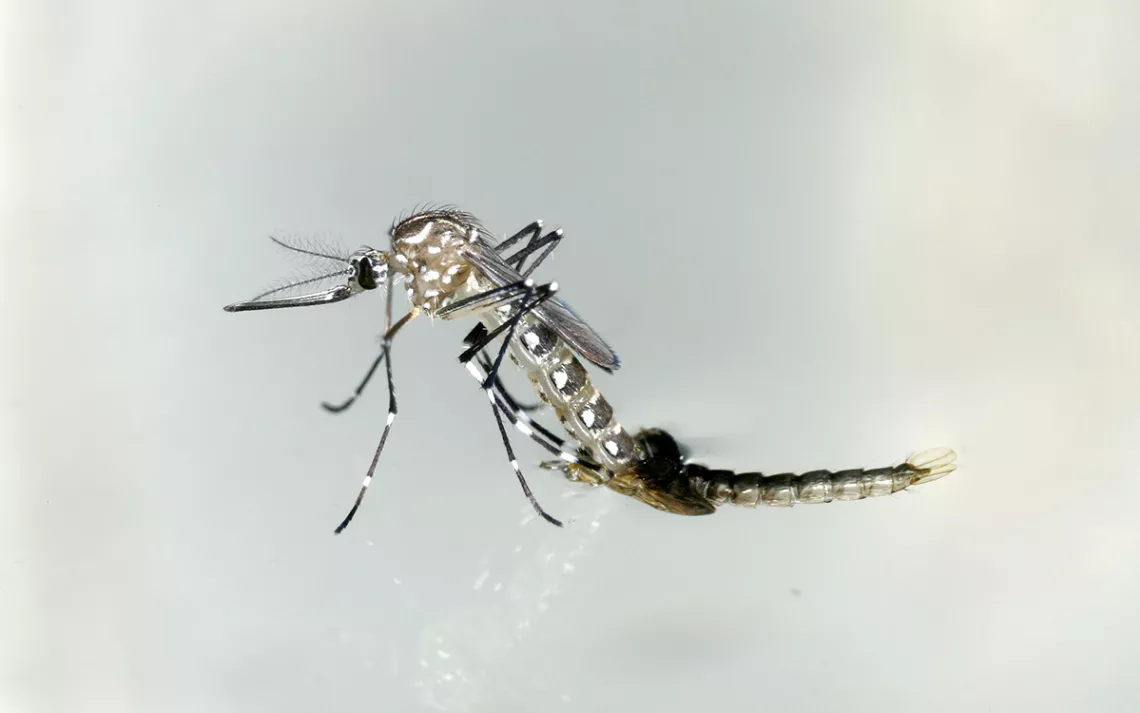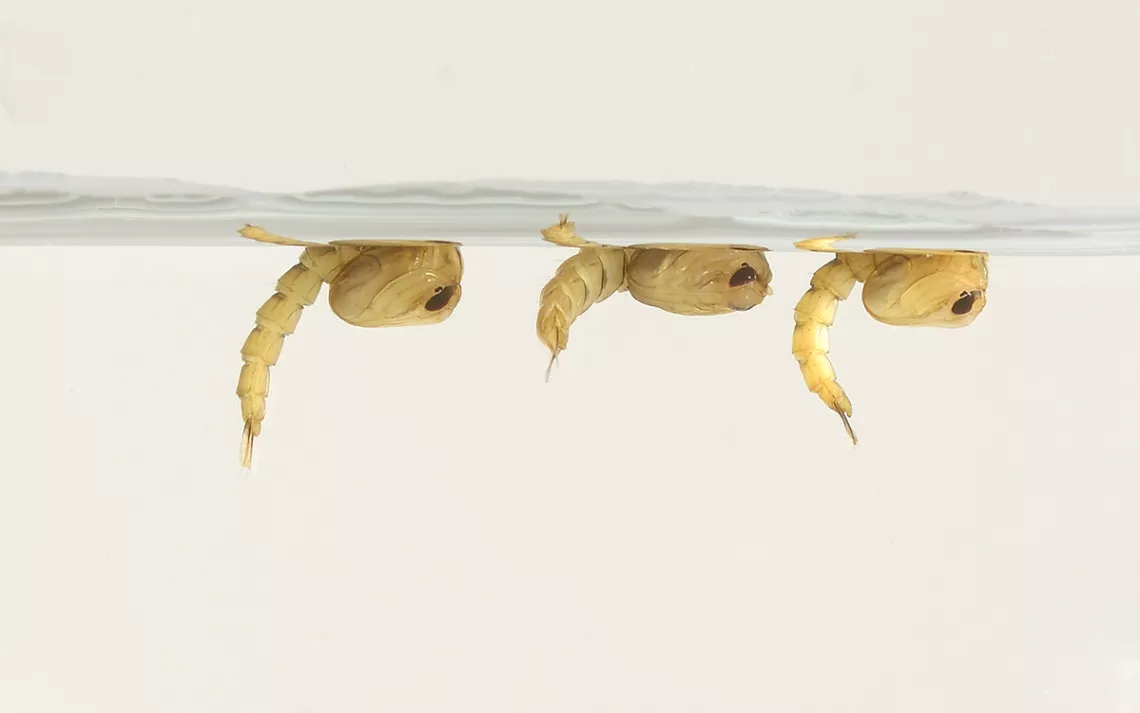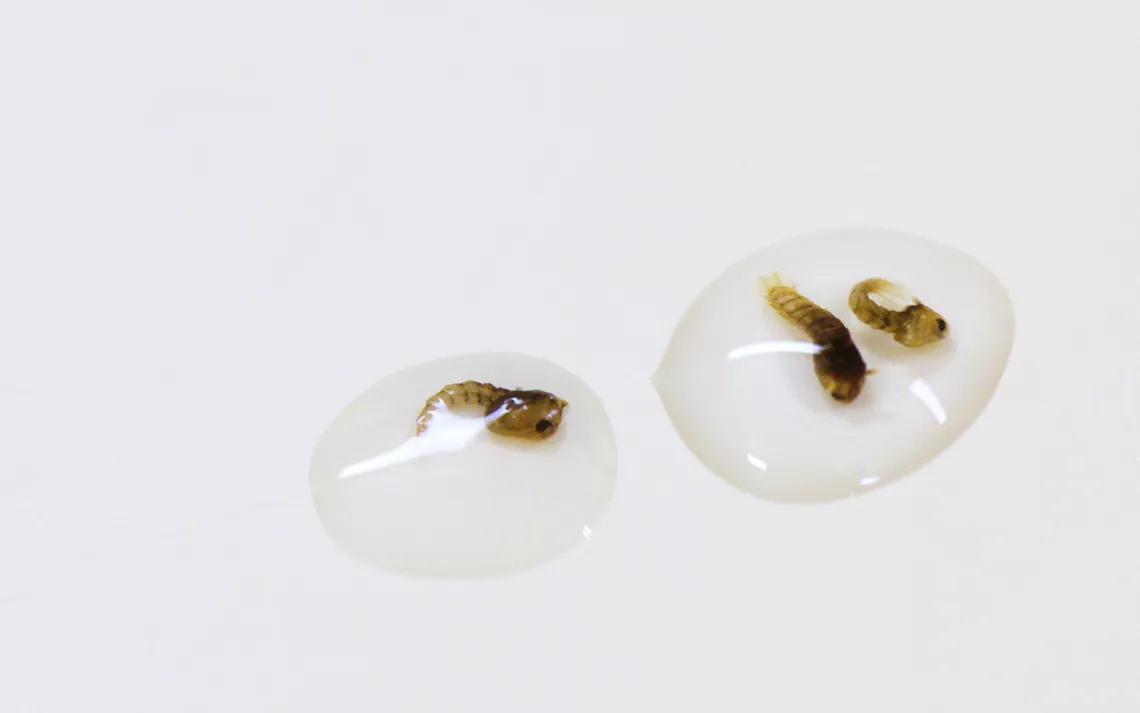Can We Kill the Dreaded Mosquito?
Do we even want to?

An Aedes aegypti mosquito | Photo courtesy of the IAEA
As a major vector for disease, the mosquito has harmed more human beings than just about any other animal, and a changing climate is only boosting those numbers. As the range of disease-carrying species of mosquitoes expands, so does their ability to transmit the parasites and viruses that result in malaria, chikungunya, Zika, yellow fever, West Nile, and dengue fever. In 2018, the continental United States saw a 25 percent increase in severe, neuroinvasive cases of West Nile virus compared with a decade earlier. And over the past three decades, the CDC reports, the worldwide incidence of dengue fever has risen 30-fold.
In cities with well-maintained infrastructure, mosquito populations can be kept in check by minimizing standing water and treating high-risk areas like storm drains. Elsewhere, lowering the risk carried by the creature that the World Health Organization describes as “one of the deadliest animals in the world" comes with its own set of complications, including new dangers to the health of humans, other species, and the ecosystems that they depend on. Here’s a short guide to the complicated science of mitigating that risk.

Pupae of Aedes mosquitoes at the Insect Pest Control Laboratory located at the FAO/IAEA Agriculture and Biotechnology Laboratories in Seibersdorf near Vienna. | Photo Courtesy of Jesus Reyes/IAEA
Insecticides
In our efforts to preserve health, reduce nuisance, and protect crops and livestock, human beings have a long history of trying to suppress insect populations. The practice of poisoning insects can be traced all the way from 2000 BCE Mesopotamia, when people dusted crops with sulfur, to our modern use of synthetic and natural pesticides. That long history means that mosquitoes have had plenty of opportunity to evolve a resistance to those chemicals, and those chemicals—most notably DDT—have had similar opportunity to accumulate in the environment and threaten other species. In recent years, mosquitoes have developed resistance to four common classes of insecticides. Insecticide-treated nets can reduce the incidence of malaria by nearly half, but (rising rates of resistance notwithstanding) some communities repurpose them as fishing nets, which indiscriminately trap all sizes of fish and pollute the water with insecticide.
Sterilization
In response to the growing global burden of mosquito-borne diseases and the above-mentioned problems with insecticides, the World Health Organization, in partnership with other United Nations branches (including a collaboration with the International Atomic Energy Agency on safety standards and risk assessment frameworks), are turning to the Sterile Insect Technique (SIT), which has been used to combat agricultural pests for more than 60 years in more than 40 countries. In this relatively straightforward method, male insects of a particular species (male insects aren’t the problem—only the females transmit disease and lay eggs on crops) are bred en masse in a lab, then sterilized via radiation. The sterile males are then released by drone in a community, where they’ll mate—but fail to reproduce—with females, thus reducing the population.
Later this year, field trials will begin to evaluate the effectiveness of SIT against Aedes aegypti mosquitoes and the diseases they transmit. Field trials will take place at preapproved sites in approximately 10 countries.
SIT’s track record in reducing target insect populations without causing significant harm to the environment make it a promising tool. However, the same radiation that renders the mosquitoes sterile can also make them less healthy, allowing their wild (and fertile) counterparts to outcompete them. Furthermore, the scale production that’s necessary to reduce large populations of sterilized mosquitoes is enormous and may be difficult to attain or maintain.
Genetically Self-limited
Another approach to withering mosquito populations is genetic editing. In its latest efforts, UK-based company Oxitec inserts “self-limiting” dominant lethal genes that pass on to subsequent generations of offspring. The edited gene causes female progeny to die before reaching adulthood, but allows males to survive and pass along the lethal gene to half of their offspring. While it still targets population numbers, this technology addresses one of the feasibility issues associated with SIT. Mosquito populations decline over multiple generations, so one introduction has a more sustained effect, yet as the population falls, the edited gene eventually disappears.
The big gain to be had from reducing populations of target mosquitoes—whether via sterilization or genetic modification—is that they should also suppress transmission of all the viruses that the species carries. There are roughly 3,500 species of mosquito in the world and only a handful—mostly within the Anopholes, Aedes, and Culex genera—carry the viruses and parasites that cause diseases such as malaria and dengue. Remove the carriers and it’s likely that other insects with fill in their niche in the ecosystem.
Animals that consume mosquitoes don’t appear to rely exclusively on a single species, or even solely on one type of insect. Decades of success with SIT in agriculture support this idea, says WHO Special Programme for Research and Training in Tropical Diseases researcher Florence Fouque: “These predators eat plenty of different insects, so if you suppress the mosquitoes, they eat other insects.” For example, in a 2009–2010 study, researchers examined prey DNA in the fecal matter collected from five species of bats in Australia. Though bats are often touted as heavily dependent on mosquitoes, the scientists found that mosquitoes represented a small proportion of the diet, even for the smallest bats, and that the bats were consuming a wide variety of species of mosquito beyond those that carry malaria.
The Replacement Strategy
At Colorado State University’s Arthropod-borne and Infectious Diseases Laboratory, Kenneth Olson is working to replace the most disease-carrying mosquitoes instead of eliminating them. For roughly 15 years, he has been developing genetically modified mosquitoes that he hopes will one day replace wild type Aedes aegypti in particular environments. “We (and others) have developed transgenic Aedes aegypti that are highly resistant to dengue and Zika viruses, at least in the laboratory,” says Olson. The goal of this and similar gene drive projects is to eventually introduce these (male) mosquitoes into a natural environment, where they will breed with wild females and spread the gene that provides disease resistance into the unmodified population. “The advantage of a replacement strategy is that we wouldn’t eliminate Aedes aegypti—if that bothers people—but instead replace the population with mosquitoes that have a virus-resistant phenotype,” Olson explains.
Gene editing’s proponents argue it’s still effective and less destructive to beneficial insects and other species than the most common alternative: insecticides. “Insecticides as a basis of vector control, they are bad for the environment and may affect beneficial insect populations. Further, insecticide treatments can be expensive, and mosquitoes are evolving resistance,” Olson says.
But gene drives also have their detractors. Once engineered mosquitoes are removed from the closed conditions of a lab, additional uncontrolled mutations may occur. And, in fact, while field trials of Oxitec’s first generation of “Friendly” Aedes aegypti did demonstrate a substantial reduction in the local mosquito population, they also found a surprise. Reporting on an independent study, Kelly Servick wrote for Science magazine that between 5 and 60 percent of the insects collected in the months after the trial had “some DNA from the Oxitec strain in their genome.” Though lab studies indicated that about 3 percent of the engineered mosquitoes’ offspring would survive, field trials demonstrated that they could reproduce and pass pieces of their genomes to subsequent generations. While none of the modified genes were passed on, this does support concerns about our ability to anticipate how things will play out in the natural environment.
Which is, arguably, the very point of the multiphased approach. Before field trials even begin, researchers must demonstrate success for generations in the lab—one line of mosquitoes has been in Olson’s insectary since 2009 (that’s 54 generations), and it remains highly resistant to the targeted arbovirus. And once they are launched, they are overseen and carried out in conjunction with host countries, local communities, and in the case of the SIT trials, multiple agencies. In its guidance frameworks for studying the efficacy and safety of various biotechnologies (including genetically manipulated mosquitoes and SIT), the WHO emphasizes the safety of nontarget organisms, responsible community engagement, and more. Gene drive engineering like Olson does is still relatively new and has yet to undergo any field trials, and guidelines for best practices are still being developed. For Olson, a key factor in protecting both the quality of research and the communities most affected by disease will be promoting transparency within the scientific community and with the public.

With the aim of eventually sterilizing and releasing them into the wild, male larvae are reared in laboratory-controlled environments. | Photo Courtesy of Dean Calma/IAEA
Is There a Better Way?
For many, including Olson and Fouque, biotechnology represents “a safer and more efficient strategy” for combating mosquito-borne diseases when compared with the insecticides that dominate today. Critics of biotechnology and especially genetic engineering are more likely to see it as an “uncontrolled ecological experiment” with too many unanticipated consequences for the environment and would rather see the energy and funding shift in different directions.
And, in fact, that research is happening as well. Scientists are developing biopesticides made from fungi; studying the efficacy of combating malaria with insecticides and antiparasitics made from nanoparticles (structures ranging from 10 to 100 nm in size) of gold, silver, and other elements; and infecting mosquitoes with a naturally occurring bacteria, Wolbachia, to reduce their lifespan and ability to transmit pathogens. Fish, tadpoles, and other aquatic animals have been shown to drastically reduce populations of mosquito larvae, though the extent to which this ends up affecting transmission remains unclear.
However, much of this work comes with the potential for unanticipated effects. Targeted biopesticides might be safer for other species threatened by conventional pesticides, but don't solve concerns raised above about how this could affect bats, birds, frogs, and other predators. Nanoparticles already occur in nature, but their impact on aquatic environments has been understudied and, as with pesticides, there is the risk of accumulation-related environmental toxicity. Even introducing natural predators to eat mosquitoes can shift ecological balance in unpredictable ways. For example, since mosquitoes represent a small proportion of birds' and bats’ diets, adding more predators could unintentionally lower populations of moths, beetles, and the other insects those predators consume.
With an array of potential solutions that are as complex as the environments in which they may ultimately be rolled out, no one solution will be perfect. We’ve already put our collective thumbs on the scale, introducing mosquito species to new regions, creating conditions in which they flourish, and trying to combat them with sweepingly toxic insecticides. Now it’s just a question of how to do the least harm.
Note: This article is independent of the Sierra Club’s policy regarding biotechnology, which opposes field release of GMOs unless they are proven safe.
 The Magazine of The Sierra Club
The Magazine of The Sierra Club



